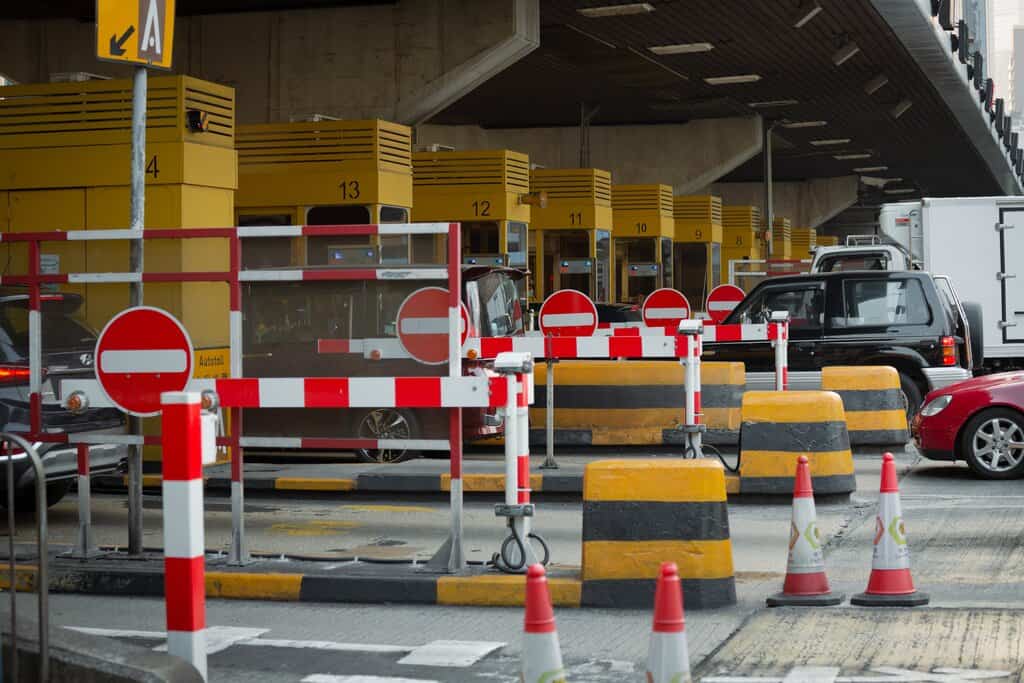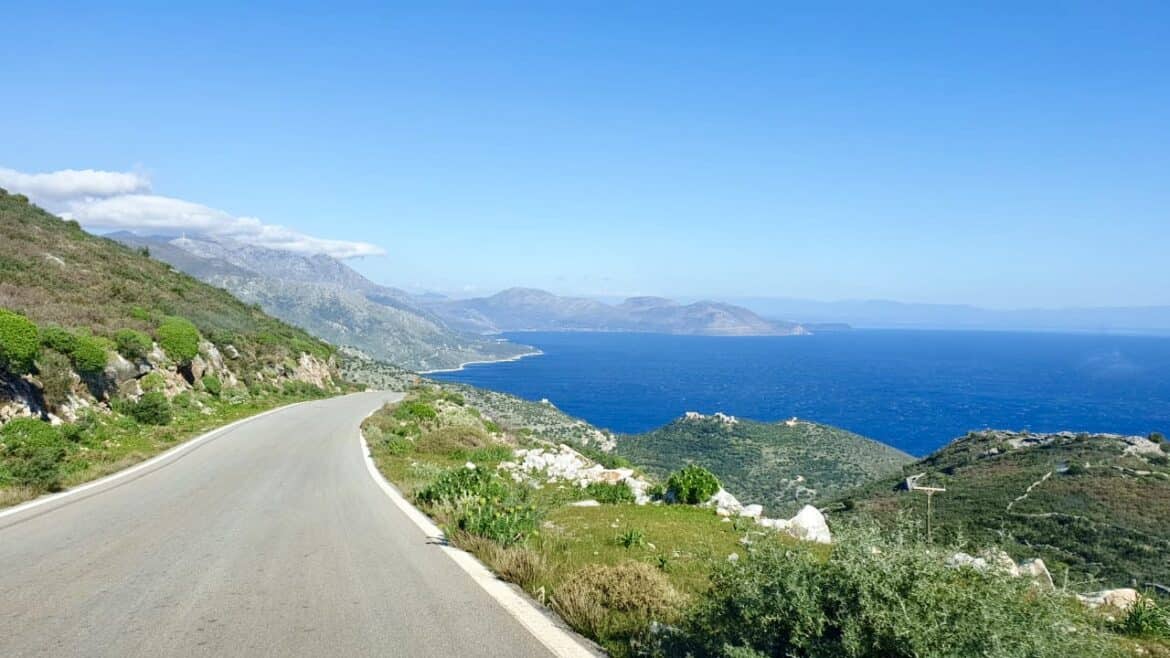Driving in Europe can be a lot of fun. But it can also be a sobering experience if you don’t know what to expect before you hit the road. So I’ve prepared this guide to 10 things you (especially Americans) need to know before driving in Europe for the first time.
I’ve driven in a lot of countries in Europe. Most of them actually. Renting a car and driving around a foreign country is one of my favorite things to do while traveling. It’s the best way to really see a country.
Sure, trains are nice. But you can’t just stop and get out if you see something cool. I always recommend renting cars when you plan on traveling outside of cities, and every country in Europe is safe to drive in.
This list of 10 things you should know before driving in Europe will prepare you for an epic road trip around my favorite continent!
- 1) The Rental Process and Insurance
- 2) International Driving Permit
- 3) Manual Transmission
- 4) Driving Conditions Vary by Country
- 5) You Cannot Turn Right on Red
- 6) Speed Cameras are Literally Everywhere
- 7) Toll Roads
- 8) Avoid Driving in City Centers
- 9) GAS PRICES
- 10) Border Crossings
- Driving in Europe – Frequently Asked Questions
- Final Word
Note: this article contains affiliate links, which means that should you purchase something or get a quote through them I may make a small commission at no additional cost to you. This helps keep the site running with up to date information. I do not represent Rentacars.com or Discovercars.com. This is information only and not a recommendation to buy the product mentioned in this article.
1) The Rental Process and Insurance
Most European airports have all the major car rental brands, as well as some of their own local agencies. I’ve rented cars in just about every European country I’ve been to and have never really had a bad experience (though waiting in line in Naples, Italy was a story in itself).
Rental rates for cars are usually significantly cheaper than you might be used to if you’re from the US (though see Point 2 below). You don’t need a special license to drive, just your home country’s license.
For booking rental cars in Europe we use DiscoverCars or Rentalcars.com. Both rental agents have a wide range of cars available in most locations throughout Europe.
In terms of insurance, most countries do not require you to purchase any mandatory 3rd party liability insurance (like in the US or Mexico). Your rental will include the required minimum. You’re also free to decline the collision damage waiver in most countries if you want to risk it.
If you have a travel rewards credit card, it’s likely you’re already covered for the CDW. I always used my Chase Sapphire Reserve to rent cars in Europe. If you don’t have a credit card with car rental benefits, it might be included in your travel insurance, or you can purchase it with the rental. I’d recommend not driving around a foreign country without some form of insurance.
We use World Nomads for travel insurance when we travel internationally and their complete plan covers rental vehicles. World Nomads provides coverage to travelers in over 100 countries. You can find a great policy on World Nomads by using the link below.
2) International Driving Permit
Some countries in Europe technically require what is known as an International Driving Permit if you’re not from a European country. So if you have an American license you’re supposed to get this permit if you’re going to one of the following countries:
- Austria
- Bosnia
- Croatia
- Czech Republic
- Germany
- Greece
- Hungary
- Italy
- Poland
- Romania
- Slovenia
- Slovakia
- Spain
Now, whether or not this permit is really required is a matter of debate. Very few car rental companies will ask for this. Prior to getting my Dutch license I had no idea this permit was even a thing and it was never a problem. I’ve rented cars twice in Italy on an American license and never been asked for this. But if you were to get pulled over by a cop it’s probably a good idea to have it.
There is really nothing you have to do to get it other than apply for one from AAA and pay $20. So it’s worth getting if you’re going to be in any of the countries listed above. You can find out how to apply for it on the AAA website. If you’re not American check with your local transportation authority for requirements.
3) Manual Transmission
If you’re not from North America, this is not going to be a problem. But if you are, and you’re under 50, you probably don’t know how to drive a stick shift. If that’s you then you have to specifically book a car with automatic transmission.
If you just book whatever car has the cheapest rate you’re going to end up with a car you can’t drive. Automatic cars are significantly more expensive to rent, but you’re just going to have to deal with it.
And do not think you’ll just learn how to drive a stick shift on the spot. It’s a long and frustrating process. If I had a nickel for every time I stalled a car at an intersection in the Netherlands when I was learning I’d have quite a few nickels right now!
4) Driving Conditions Vary by Country
One thing we have to discuss when talking about driving in Europe is that the road conditions can vary greatly depending on the country. The differences in the roads between Germany and Bulgaria cannot be understated. That being said, even the poorer countries have excellent infrastructure and adequate road signage, even if some of the roads are covered in potholes.
The best roads are in northern Europe. The Netherlands has a vast network of highways for such a small country. Germany, France, Denmark, the UK, etc, all have excellent road networks. Southern Europe gets a bit more varied.
Some of the highways in Spain are pretty questionable. But Italy has an amazing motorway network. Driving through the Italian Riviera near Genoa you’ll be amazed at the tunnels and bridges that allow a highway to pass through some of the most mountainous terrain you’ll ever see. And Greece’s roads are sufficient for amazing road trips.

For European countries, the most hectic driving experience I’ve had was Georgia, without a doubt. In fact I’ve written a special Guide to Driving in Georgia because it warranted its own post. But even then, it was doable and fun. I’ve never driven in south Asia (where my wife is from) and never will. At least Georgia still has rules!
5) You Cannot Turn Right on Red
The rest of the world won’t find this surprising, but for Americans this can be a mistake that leads to a ticket. The US and Canada are the only countries I’ve even driven in where you can legally turn right on a red light. Everywhere else you just can’t do it. You have to wait until the light turns green. So be aware of this while driving around Europe and don’t get a fine in the mail.
6) Speed Cameras are Literally Everywhere
Speaking of fines, if you’re not driving the speed limit you will get a ticket. Doesn’t matter what country you’re in. All of them have speed cameras all over their roads.
Cops taking radar from their cop cars? Ugh no, that’s an American thing that the rest of the world laughs at. European countries have entered the 21st century and will give you a ticket without needing to pay a policeman to sit in a car.

You must drive the speed limit when driving in Europe. Unless you’re prepared to pay the fines there’s just no way around it. I got more speeding tickets in 4 years living in the Netherlands than I did the rest of my life combined. And I didn’t even own a car! That was just when I rented a car to get out of town. They always got me when the speed limit would drop from 90 to 70 or something like that. Pay attention to the speed limit signs!
On a positive note, speed limits in Europe are typically adequate and you shouldn’t feel like you need to speed. Highways in most countries are 130 kmh (about 80 mph). I’ve only seen that in west Texas in the US.
In Germany it’s even better. On highways between cities there literally is not a speed limit. I’ve been doing a cool 160 (100 mph) and had people blow by me in the left lane. Don’t drive in the left lane in Germany unless you plan to break the sound barrier!
7) Toll Roads
Another thing that will get you is the toll roads. These vary by country, but in many European countries the motorways are not free to drive on. And they are not exactly cheap either. If you plan on driving 250 miles across northern France you better be prepared to pay about 30 Euros or take the back roads. Tolls vary per country but are generally based on how far you drive.
In the following countries you are required to pay a toll to use the motorways:
- Austria
- Belarus
- Croatia
- Greece
- Hungary
- Ireland (not every motorway)
- Italy
- Norway (not motorways, but many tunnels/bridges, of which there are many)
- Poland
- Portugal
- Spain
- UK (some portions of motorway)
- Switzerland (confusing system but if you rent a car in Switzerland you shouldn’t have to pay toll, see (https://www.myswissalps.com/motorwayvignette).
This is not an exhaustive list so best to double check your destination’s toll road situation before your trip and always ask the rental car company about tolls and how to pay tolls while picking up your car. Some of the countries with great highways that you don’t have to pay to drive on are the Netherlands, Belgium, Germany, and Finland, for example.

8) Avoid Driving in City Centers
European city centers are old. Like centuries before cars were invented old. Roads are typically very narrow and parking is few and far between outside of designated garages. It’s common to find a delivery truck just blocking the road while making a delivery because there’s nowhere to pull over.
If you can avoid driving in the city centers you should. It’s not worth the hassle. European cities are usually not car-centric like American or other New World cities. While the roads are in good shape, cars are secondary to pedestrians and public transport.
For as many times as I drove in central Amsterdam while I lived there I still never got used to it. With thousands of tourists walking around, the locals on their bikes, the buses, trams and everything else it was just a daunting experience.
If you must drive through a city center, go very slow and constantly be on the lookout for things like people crossing the street without looking and trucks stopping with no warning. Pay attention to your surroundings.
I almost hit a guy holding a baby in Naples after he darted out in front of my car to catch a bus. If I hadn’t been anticipating it I could have literally killed a baby. So just be careful when driving in the city!
9) GAS PRICES
Newsflash Americans: you have the cheapest gas in the developed world. Gas prices in the US are so much cheaper than Europe it’s not even funny. Americans complain about gas being $4/gal. Europeans would kill for that price!
In most countries, prices will range from between $5-8 per gallon. And that was before Russia invaded Ukraine! If you’re in Iceland or Norway, prepare to pay up to $9 per gallon, depending on the price of oil.
The main reason gas is so much more expensive is that the petrol taxes are high in Europe. Europe is not a car based society and the governments charge hefty fees to drive with gas taxes. So don’t be shocked when filling up your rental car costs $100.
10) Border Crossings
Thanks to the Schengen Zone, driving around Europe is super easy when it comes to border crossing. If you’re leaving one Schengen country into another there really isn’t a border, just a sign welcoming you. You’ll have to pay attention to the new road signs and speed limits, but that’s really about it.
If you’re entering or leaving a non-Schengen country, however, you’ll have to go through immigration, just like you would at an airport. Given how most of mainland Europe is in the Schengen Zone, you’re only really dealing with this if you’re driving in Croatia, Bosnia, Serbia, Albania, Romania, North Macedonia, Montenegro, Kosovo, or Bulgaria.
I’ve done a road trip through Croatia, Bosnia, and Montenegro before, but it was in winter so the border crossings were not crowded at all. If you’re planning on doing the gorgeous drive from Dubrovnik to Kotor in the summer though, prepare to wait over an hour at the border crossing.
Lastly, pay attention to the terms and conditions of your rental car agreement. When I rented a car in Bulgaria I was not allowed to leave the country. I was close to the Greek border but couldn’t enter Greece. In Croatia, I had to pay extra for a permit that let me take the car out of the country into Bosnia and Montenegro. The border guards checked this permit as well.
Driving in Europe – Frequently Asked Questions
Can I drive in Europe with a US license?
Yes, you can drive legally in Europe with a US license. If you move to Europe, you’re supposed to get a local driver’s license within 3-12 months, depending on the country, but that rule is not strictly enforced.
Do they drive on the left or the right in Europe?
Mainland Europe drives on the right side of the road. There are no countries on the mainland that drive on the left. The only countries that drive on the left in Europe are the island nations of the United Kingdom, Ireland, Malta, and Cyprus.
Can you drive between countries in Europe?
You can drive between all countries in Europe. Depending on if the country is a member of the Schengen Zone or not, you may or may not have to show your passport at an immigration checkpoint. If you’re driving between Schengen Zone countries (such as from Belgium to France) there is no border crossing. If you’re driving to or from a non-Schengen Zone country (such as from Hungary to Romania) you’ll have to go through immigration.
Can you turn right on red in Europe?
No. Don’t do it. Not worth getting a ticket for.
Final Word
Driving in Europe is the best way to discover the continent. By renting a car and getting out onto the open road you’ll see many things that the city-centric tourists never get to see. I’ve driven in almost every European nation and I can adamantly say it’s the best way to really see a country. But it’s not without its challenges, especially for any American driving outside of the US for the first time. If you’re prepared, though, you’ll have an epic adventure on my favorite continent!


1 comment
[…] three hours from central Madrid. If you’re driving into the city, be sure to check out my guide to driving in Europe […]